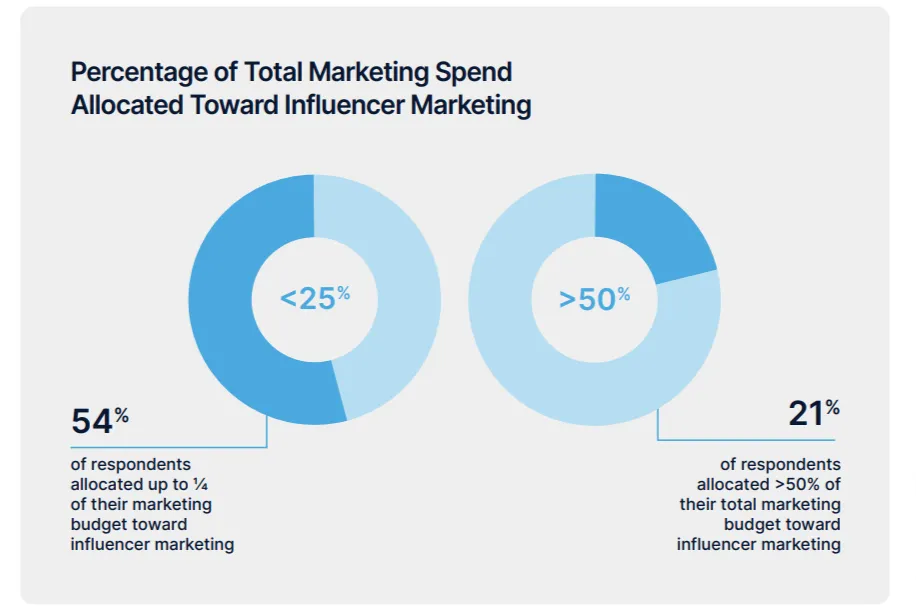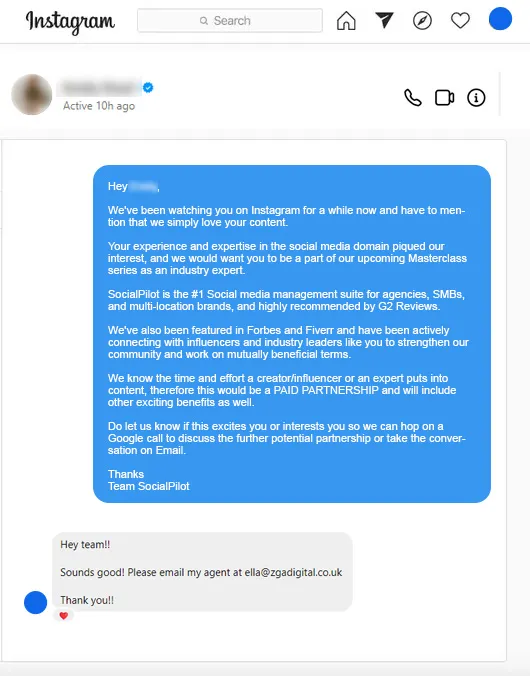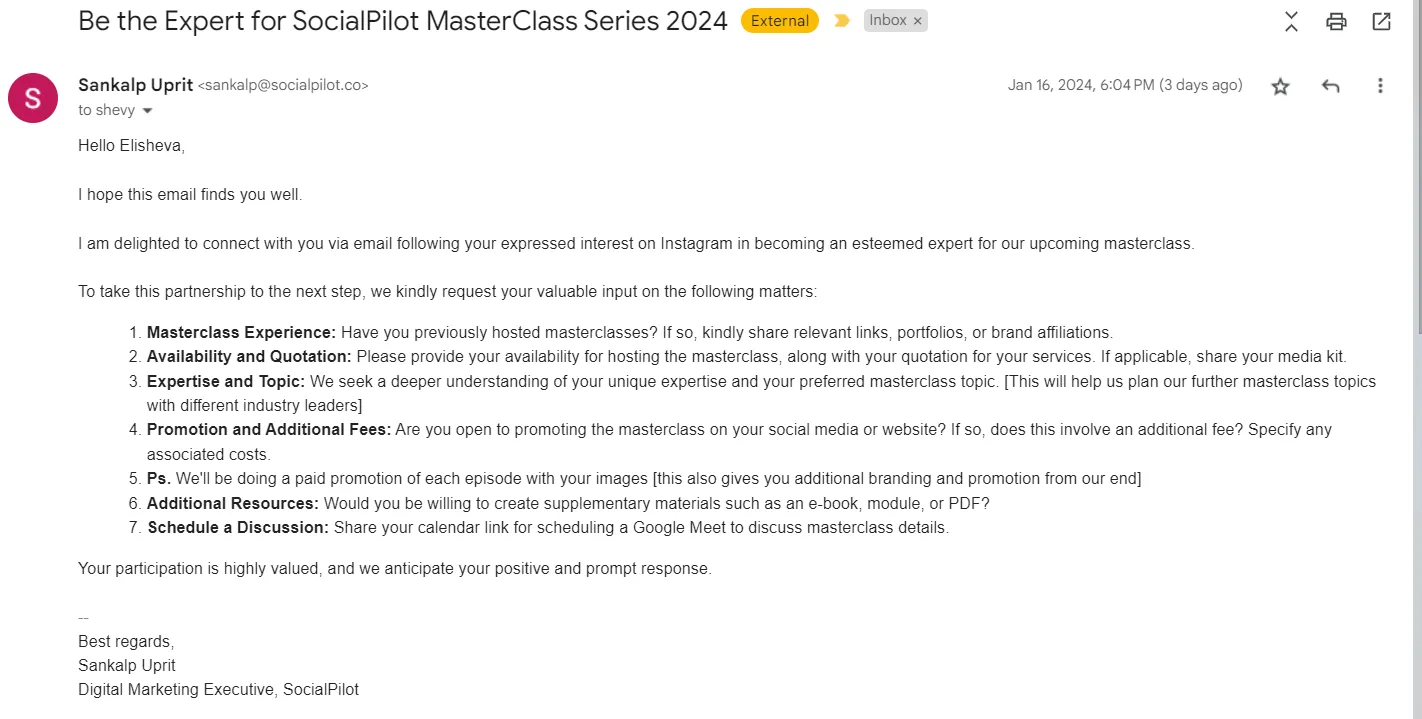More and more brands have started spending on influencer marketing to reach new audiences.
This surge is so significant that the global influencer marketing landscape is projected to reach $22.2 billion by 2025.

No surprises there.
Influencer marketing is indeed one of the most effective ways to reach potential customers, make a genuine connection, and eventually turn them into buyers.
However, creating an influencer marketing campaign that yields great results is easier said than done. It’s more than randomly picking any individual with a big follower count.
The process of finding, vetting, and selecting an influencer – as well as executing the entire influencer marketing campaign – runs more smoothly when guided by proper influencer marketing strategies.
We at SocialPilot have yielded great results by collaborating with niche-specific influencers. I can say the crux of our successful campaign lies in the influencer marketing strategies we follow.
I have unraveled the same strategies in this blog that you can follow to create impactful influencer marketing campaigns effectively.
Let’s go!
What is an Influencer Marketing Strategy?
An influencer marketing strategy is made up of a set of steps that involves setting specific goals for influencer marketing campaigns and finding the right influencers to achieve those goals.
When you follow a well-structured strategy, you are making sure that your influencer marketing efforts are aligned with your overall marketing goals, effectively reaching your target audience and fostering long-term relationships with influencers.
I have seen new marketers collaborating with random individuals based on their follower count, only to end up with vanity metrics like views that don’t translate into tangible ROI.
A strategy is just the opposite of randomness.
By following a strategic approach, you ensure that you are selecting the most relevant influencers who will connect you with the most relevant audience who are more likely to convert.
How Do You Create a Full-Proof Influencer Marketing Strategy?
Influencer marketing is not an overnight game. You need to start creating an influencer marketing strategy way before you plan to launch the campaign.
Starting too late can lead to rushed decisions, irrelevant influencer options, one-off collaborations, and oh-not-so-impactful campaign results.
Let me take you through the strategies that helped us create and manage influencer campaigns for SocialPilot at every stage of the way.
1. Set Your Influencer Campaign Goals
Every marketing strategy starts with setting up a set of goals. Influencer marketing is no different.
Your goals guide every decision you will make throughout the influencer campaign, including the type of influencer you select, the platform you target, and the metrics you’ll use to measure success.
Of course, the goals you select will come from your overarching marketing goals. For example, our overarching marketing goals were:
- Increasing product awareness
- Lead generation
- Market penetration in a specific niche
- Strengthening brand positioning
- Driving conversions
That led us to collaborate with Luke Shalom, a micro-influencer with over 49K followers on Linkedin. We used his popularity among our target audience to promote our latest AI assistant feature. Not only that, we came up with personalized coupon codes to drive conversions.
The goals you set need to be measurable. You need to define the key metrics you will track to measure the campaign’s success. Goals without KPIs can be challenging for both you and your influencer to create impactful content and accurately gauge performance.
To ensure clarity and focus, we established precise Key Performance Indicators (KPIs) for Luke:
- Expected Impressions/per post: 40,000
- Expected Engagement Rate/per post: 2 – 4%
- Expected Conversions (overall): 0.3 – 0.5%
Your set goals and KPIs also open up doors to one more important question- how much are you going to spend?
2. Define the Budget
Recent statistics suggest that 82% of marketers have defined a dedicated budget for influencer marketing.
You should be part of the list.
Dedicating a portion of your overall marketing budget to influencer marketing from the onset will help you create long-term influencer campaigns. A Creator IQ survey sheds light on how much of the overall marketing budget marketers allocate to influencer marketing.

The question is, how do you define your influencer marketing cost?
- The most important factors are your goals. If you aim for a particular conversion rate, say 3 to 4%, then calculate how much revenue these conversions will generate. This will help you calculate how much you can reasonably invest to get a positive ROI.
- The next thing to consider is your industry’s influencer rates. You don’t know the exact influencer you will be working with at this stage, but you can get an idea about the average rates different types of influencers charge in your target niche. You can get such information from influencer marketing tools, platforms, and agencies.
In our case, I discovered that the normal cost of micro-influencers in our industry varied from $150 to $2,000. This starting point helped me come up with a number that I could talk about with our leaders.
Remember, a well-planned budget is key to a successful influencer marketing campaign. It ensures that you can afford the right influencers and activities to meet your goals without overspending.
3. Find the Right Social Media Influencers
You’ll be aware of the goals and the budget at this stage. Now is the time to find the influencers that align with your niche, fit within your budget, and are influential enough to achieve your goals.
Usually, no one starts with a blank page.
You’d already have someone in mind whose content you’ve been keeping up with, and you know that your target audience follows them, too.
That’s exactly why we chose to collaborate with Luke. He is an influential figure in the world of social media marketing on Linkedin and has an established community of people overlapping with our targeted ICP. Better yet, he was also a happy user of SocialPilot.
But if you don’t have such a sweet deal or want to run multiple influencer campaigns requiring multiple influencers, you can use the below methods:
Manually Find the Influencers
Manually finding the influencer is the cheapest but the most time-consuming way.
If your goals include any social media platform, then you start there; if not, then start with the platform where you are already active.
Manually finding influencers means looking out for individuals on social media who are driving the conversion on topics around your niche. You can do that by using social listening tools to track industry-relevant hashtags and brand mentions.
We at SocialPilot find influencers who specialize in the social media domain and cater to businesses or marketing agencies using keywords like “social media coach,” “social media content creator,” or “agency marketing.”
Use Influencer Marketing tools
Using influencer marketing tools is much simpler. You can use tools like tools like AspireIQ, Upfluence, or FameBit to find the perfect influencer for your business.
They manage a database of millions of influencers that you can filter based on the niche, location, audience demographics, and engagement rate to find the right fit for you.
Hire an Influencer Marketing Agency
If you have enough budget to spare for the influencer-finding process, you can hire an influencer marketing agency. This method is expensive but the most hassle-free and human.
Influencer marketing agencies personally nitpick and collaborate with influencers from different niches. You can trust the authenticity of influencers they will find for you.
Also, you get assigned real people who will take care of the end-to-end process of finding influencers, collaborating with them, managing the campaign, and tracking the performance.
Key Evaluation Factors to Consider
Consider these key factors when evaluating influencers:
- Relevance: Check if the content they share aligns with your brand and industry
- Genuine Engagement: Ensure that the people interacting with them are authentic and not automated bots leaving generic comments
- Authentic Followers: Verify that their follower list consists of real individuals
- Brand Alignment: Evaluate whether their content style matches your brand guidelines
Once you have made a list of influencers who you think will be a great fit to carry out your brand promotions, start reaching out to them.
4. Reach Out and Collaborate
I reached out to Luke on LinkedIn for the collaboration, and I received a prompt response because he actively interacts with his audience through direct messages.
This is a typical trait you’ll find in micro-influencers of the lower and mid-levels. So, you’re likely to receive a response when you ping them through the platform where they are active and popular.
However, as influencers gain more followers, the chances of getting a reply from them via direct messages decrease.
In such cases, you may need to contact them through the website or cold email them at the address they provide in their profile bio, which might be managed by their manager or an influencer marketing agency.
Your actual work with the influencers starts at this stage. But what do you tell them?
Your initial message with influencers requires a balance of brevity and charm. Begin by introducing your brand and genuinely appreciating their work.
Make your intentions clear and then smoothly guide them toward switching to email for a more organized conversation if they show interest in collaborating. And, of course, ensure you mention what you will give back in return – money or products.

Your objective is to move the conversation to email so you can explain your campaign in more detail to the influencer.

In the series of email exchanges, with frequent phone/video calls in between, you need to clearly:
- Explain the plan: Talk about what you want to do in the campaign. Explain all the details, like campaign messaging, how many posts you’d like, what kind of content, and any special requests.
- Talk about payment: Be clear about how you’ll pay them. It could be a fixed amount, a percentage of sales, or free products.
- List what’s expected: Describe exactly what you expect them to do, including deadlines and any rules about the content they create.
- Negotiate: If they have questions or want to change something, have a friendly discussion. It’s about finding a deal that works for both of you. This might involve back-and-forth discussions on pricing, additional perks, or any revisions to the initial proposal.
- Finalize with contract agreement: The need to prepare a comprehensive influencer contract outlining all agreed-upon terms is paramount. Put down in writing everything you have agreed upon, including the number of deliverables, content ownership, payment schedules, content revision fees, exclusivity clauses, and any legal considerations.
5. Review the Content Creation
You play the part of the reviewer in the actual content creation process and leave most of it to the influencer.
With Luke, we outlined the number of deliverables and content format (carousel) at the collaboration stage. After that, the ball was in his court to work his magic and come up with a storyline for the post.
Giving that freedom to the influencer is a necessity.
Influencers know the kind of content their audience enjoys. If you meddle too much and end up posting something that doesn’t match the influencer’s usual voice, it will backfire for you and the influencer. Plus, the micromanagement will also ruin your relationship with the influencer.
Of course, it doesn’t mean that you don’t involve yourself at all. Influencers can sometimes lose sight of your brand messaging. That’s where you need to jump and help them with the details of your brand tone, style guide, visual branding elements, and key messaging points.
The key is to find a balance between your brand messaging and influencer creativity.
6. Monitor the Campaign Performance
Tracking the performance of your campaign from the get-go will help you figure out if your influencers are really achieving the assigned goals. This way, you get more time to adjust your strategy and optimize the remaining campaign.
At this stage, you return to the goals and relevant metrics you had set initially.
- You can track brand awareness and engagement metrics, such as likes, comments, mentions, and shares, through native or third-party social media analytics tools. Since the post gets published on your influencer’s account, they will be providing you with the data. However, the engagement will also come to your profiles as well. In our case, along with Luke, SocialPIlot’s LinkedIn page also saw a drastic engagement rise of 7%, and the impression grew to 25,000 in the week Luke posted.
- If your aim is to increase visitors to your website, tools such as Google Analytics come in handy to observe how much of this traffic comes from the posts made by influencers.
- You can use UTM (Urchin Tracking Module) codes to get a granular view of how well different platforms or specific influencer collaborations are performing. These are small pieces of code attached to your URLs, giving you a clearer picture of where your traffic is coming from and how users interact with your content.
- Moreover, for campaigns where you’re encouraging people to make a purchase or sign up using an influencer’s promotion, assigning distinct discount codes to each influencer can be a smart move. This strategy makes it easier to identify and measure the success of purchases or sign-ups and the overall ROI that can be credited to their promotion.
Wrapping Up!
A successful Influencer marketing takes more than hiring people with a big follower count.
It requires a well-structured influencer marketing strategy that guides you before and after making your campaign live.
Remember to carefully plan things like setting clear goals, picking influencers who fit well with what your brand stands for, and keeping a close eye on how the campaign is doing.
By paying close attention to these details and remaining adaptable to the insights gained from each campaign, you position your brand to leverage influencer marketing effectively.
Here’s to crafting influencer collaborations that truly resonate with your audience and drive your brand forward.




